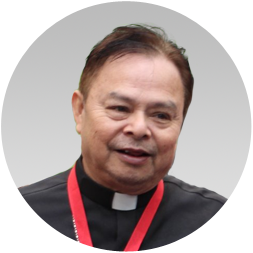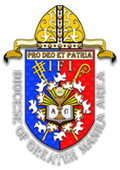BIRHEN BALINTAWAK:
The IFI’s Indigenous Virgin Mary
(Sketches from History)

By: The Rev. Dr./Fr. Hermogenes P. Verano
Missionary Priest of the Diocese of Greater Manila Area

"The image of Birhen Balintawak is one of the two images of the Blessed Virgin Mary (BVM) of the Iglesia Filipina Independiente. [The other one is the Birhen Maulawin in Santa Cruz, Laguna.] It portrays the BVM wearing the native Filipino dress with the Child Jesus wearing the uniform of the Katipunero, with the banner streaming the aspiration of the Filipinos from the bondage of Spain and America, saying, ‘Ama, Sumilang Nawa ang Aming Pagsasarili.’ The image highlights the liberative message of God's intervention in human history and proclaimed by Mary in the ‘Magnificat’ as expressed in the IFI's participation in the people's struggle for the reign of justice, peace, and independence in our land; for the emancipation of our women from the domineering system of patriarchy in our society and the empowerment of women in the church's life and work." (Message of the Obispo Maximo Rhee Millena Timbang on the Feast of Birhen Balintawak on August 26, 2020.)
Icons or statues of saints are permanent fixtures of Catholic and Independent Churches. They serve as visual aids for the faithful. Those icons remind them of the good deeds of the saints who were able to live up to the expectations of a saintly life following Jesus's examples.
One of the most important and popular icons is the Virgin Mary, the Mother of Jesus the Lord, Son of God. She has different names: Mother of Perpetual Help, Our Lady of Assumption, Our Lady of Fatima, Virgin Mary of Antipolo (Our Lady of Peace and Good Voyage), Lady of Penafrancia, Our Lady of Grace, Mother of the Immaculate Conception, Our Lady of the Miraculous Medal, and many others. Aside from being the Mother of God, her exemplary life as the ever embodiment of an obedient Handmaid of the Lord remains very dear to us believers. Hence, we put her on the pedestal like any other godly saints.
But the idea of veneration of the Virgin Mary did not escape from the philosophical wisdom of the Katipuneros and revolutionaries like Msgr. Gregorio Aglipay and Aurelio Tolentino and as a result of the people's struggle for political as well as religious independence in the 1900's, a symbol came to the fore, The Virgin Mary of Balintawak, or the Birhen Balintawak.
“In 1905, the Calendario de la Iglesia Filipina Independiente [IFI Calendar] marked August 26 very boldly as "Pista ng Kalayaan" [Independence Feast]. Visible during this celebration was the icon of "Birhen Balintawak," while the most emotionally filled phase was the chanting of the prayer for "veteranos de la revolucion" (veterans of the revolution). With the Holy Mass celebrated in the vicinity of Andres Bonifacio's statue in Balintawak (Caloocan), who wouldn't cry for God and for Country?” (Fr. Mario Varona, doctoral dissertation; PhD., University of the Philippines).
The concept of Birhen Balintawak originated from a writer named Aurelio Tolentino who was also a Katipunero himself. In his article in "La Vanguardia" a publication in the 1900, “he said that a certain Katipunero dreamed of ‘Birhen Balintawak’ on the night before the discovery of the Katipunan in August 1896.” This story was infused in the Novena or "Pagsisiyam ng Birhen Balintawak" in 1920 by the legendary revolutionary priest Gregorio Aglipay.
In the book "Looking Back" written by Professor Ambeth Ocampo in August 2015, it states: "When he was still living, the journalist Aurelio Tolentino used to say that one night when Andres Bonifacio, Emilio Jacinto and comrades were sleeping in the house of Tandang Sora (Melchora Aquino) in Balintawak, one of them saw in a dream a beautiful Mother dressed in the style of the farmers of Balintawak, leading a pretty child by the hand, dressed like a farmer with short red pants and holding a shiny bolo crying, ‘Liberty! Liberty!’ (Kalayaan). The beautiful woman approached the one dreaming and said to him, ‘Be careful.’ When the dreamer woke up, he told his comrades what he had dreamed saying that the Mother and Child had the face of the Europeans though dressed like Filipinos.”
Because of this, they did not follow their plan to return to Manila for their regular work but decided to wait awhile in Balintawak. It was not long before the news came that the Guardia Civil Veterana had raided the printing press of "Diario de Manila" and captured a number of Katipuneros and their papers. Because of this dream, Aurelio Tolentino added, “the first soldiers of the Katipunan wore red trousers.” But without this dream, Andres Bonifacio and his staff would have been captured and we would still not be “free even now."
In relation to this, Fr. /Dr. Mario Varona, in his UP doctoral dissertation entitled, "ANG BIRHEN SA BALINTAWAK AY ANG INANG BAYAN: AN INTERPRETIVE STUDY," gave some instructive commentaries illustrative of the reasons why "the religious and nationalist ideals of the Pro Deo et Patria religion is reflected by the Blessed Virgin Mary while the country by the Katipunero's aspiration for independence."
Quoting Ocampo again, "The Mother of Balintawak, says Msgr. Aglipay, reminds you constantly of your sacred and inescapable duty to make every effort possible to obtain our longing for independence; and she is the sacred image of our Country. The voice of the people will constantly resound from our pulpits reminding you of the great teachings of Rizal, Bonifacio and other Filipinos, and the teachings of our greatest compatriots will form the special seal of our National Church."
In another excerpt from Ambeth Ocampo's "Looking Back” (2015), Obispo Maximo Gregorio Aglipay reiterated: "The Mother of Balintawak symbolizes our Country and the Katipunan child expresses to the Filipino rising generation which longs for independence, and both figures constantly remind us of the tremendous sacrifices of the liberators of our country and our sacred and inescapable duty to follow them, also making all possible sacrifices on our own part to achieve our independence."
"An appropriate symbol to articulate political struggle," he said, "it provides for the affirmation of the need of social unity in which members must be absorbed... it calls for a change in the existing social order and that transformative call embodies the future while it links that future with the past."
Furthermore, to quote Fr. Varona: "The icon of Birhen Balintawak confirms the dictum that, 'deities cannot be invented simply because there is a need for them.' They must grow out of an intense experience which people share. The experience of the Filipino people during the three centuries and a half under the Spanish colonialism and the first two decades under American imperialism provided them a panorama of untold sufferings, the desecration of Filipino womanhood is similar to the ravage inflicted upon Mother Country who is egging her sons for her defense. Not merely expressing a transient defiance, the icon expresses the reversal of historical experience. For while it is true that Mother Country was defeated and her struggle nullified by the American aggression, the icon reverses the position from a defeated one to a hopeful, ready for action position expressing a dynamic and active possibility.”
For your information, "the wooden statue of the Birhen Balintawak was first enthroned in the Maria Clara IFI Church at V. Concepcion St., Sampaloc, Manila and is adjacent to the old ancestral house of Don Isabelo de los Reyes Sr., the precursor of the founding of the Iglesia Filipina Independiente Church” (Varona, 20?). It is also enthroned as a giant mural at the left side of the main altar of the National Cathedral of the Holy Child at Taft Avenue, Manila. In the Sucat IFI Mission Chapel, the said icon is venerated by the faithful/believers composed of migrants from the Visayan Islands (mostly Ilongos and Antiquenos) in which I was formerly assigned as mission priest. [The Rev. Fr. Ricardo Aliwalas is the incumbent mission priest, as of this writing.]
With the endorsement of the Obispado Maximo and the Diocese of Greater Manila Area, the propagation of the veneration of the Birhen Balintawak is encouraged to spread to all over the IFI churches in the Philippines.
(Inquisitively, this writer is pondering as well as wondering: What is the policy of our Church regarding creating icons and saints for veneration? In jest, we can have our own like St. Hermogenes of Aloran. Joke only.}


